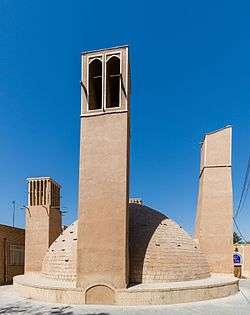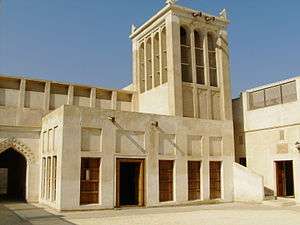Windcatcher
A windtower (wind catcher) (Persian: بادگیر bâdgir: bâd "wind" + gir "catcher" is a traditional Persian architectural element to create natural ventilation in buildings.[1] Windcatchers come in various designs: uni-directional, bi-directional, and multi-directional. Windcatchers remain present in many countries and can be found in traditional Persian-influenced architecture throughout the Middle East, including in the Arab states of the Persian Gulf (mostly Bahrain and Dubai[2]), Pakistan, and Afghanistan.[3]
Background
Central Iran shows large diurnal temperature variation with an arid climate. Most buildings are constructed from thick ceramic with high insulation values. Towns centered on desert oases tend to be packed very closely together with high walls and ceilings, maximizing shade at ground level. The heat of direct sunlight is minimized with small windows that face away from the sun.[3]
The windcatcher's effectiveness had led to its routine use as a refrigerating device in Persian architecture. Many traditional water reservoirs (ab anbars) are built with windcatchers that are capable of storing water at near freezing temperatures during summer months. The evaporative cooling effect is strongest in the driest climates, such as on the Iranian plateau, leading to the ubiquitous use of windcatchers in drier areas such as Yazd, Kerman, Kashan, Sirjan, Nain, and Bam.
A small windcatcher is called a shish-khan in traditional Persian architecture. Shish-khans can still be seen on top of ab anbars in Qazvin and other northern cities in Iran. These seem to function more as ventilators than as the temperature regulators seen in the central deserts of Iran.
Windcatchers in Egypt

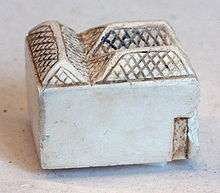
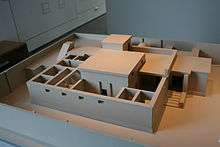
The windcatchers are known in traditional Egyptian architecture in Ancient Egypt as demonstrated in Windcatchers on the Pharonic house of Neb- Ammun, Egypt, 19th Dynasty, c.1300 BC, British Museum.[4] It was revived in Neoislamic architecture as the works of Hassan Fathy. In Egypt the windcatchers are known as malqaf pl. malaaqef.[5][6][7][8]
Structure and architecture
Windcatchers tend to have one, four, or eight openings. In the city of Yazd, all windcatchers are four- or eight-sided. The construction of a windcatcher depends on the direction of airflow at that specific location: if the wind tends to blow from only one side, it is built with only one downwind opening. This is the style most commonly seen in Meybod, 50 kilometers from Yazd: the windcatchers are short and have a single opening.
To keep buildings free of dust and sand blown in from the desert, windcatchers were built facing away from the wind.[9]
Function

The windcatcher can function in three ways: directing airflow downward using direct wind entry, directing airflow upwards using a wind-assisted temperature gradient, or directing airflow upwards using a solar-assisted temperature gradient.
Downward airflow due to direct wind entry
One of the most common uses of the windcatcher is to cool the inside of the dwelling; it is often used in combination with courtyards and domes as an overall ventilation and heat-management strategy. It is essentially a tall, capped tower with one face open at the top. This open side faces the prevailing wind, thus "catching" it, and brings it down the tower into the heart of the building to maintain air flow, thus cooling the building interior. It does not necessarily cool the air itself, but rather relies on the rate of airflow to provide a cooling effect. Windcatchers have been employed in this manner for thousands of years, as detailed by contemporary Egyptian architect Hassan Fathy.[10]

Upward airflow due to temperature gradient
Wind-assisted temperature gradient
Windcatchers are also used in combination with a qanat, or underground canal. In this method, the open side of the tower faces away from the direction of the prevailing wind (the tower's orientation can be adjusted by directional ports at the top). By keeping only this tower open, air is drawn upwards using the Coandă effect.
The pressure differential on one side of the building causes air to be drawn down into the passage on the other side. The hot air is brought down into the qanat tunnel and is cooled by coming into contact with the cool earth[Note 1] and cold water running through the qanat. The cooled air is drawn up through the windcatcher, again by the Coandă effect. On the whole, the cool air flows through the building, decreasing the structure's overall temperature. The effect is magnified by the water vapour from the qanat.
Solar-produced temperature gradient
In a windless environment or waterless house, a windcatcher functions as a solar chimney. It creates a pressure gradient which allows hot air, which is less dense, to travel upwards and escape out the top. This is also compounded significantly by the diurnal cycle, trapping cool air below. The temperature in such an environment cannot drop below the nightly low temperature.
When coupled with thick adobe that exhibits good resistance against heat transmission qualities, the windcatcher is able to chill lower-level spaces in mosques and houses (e.g. shabestans) in the middle of the day to frigid temperatures.
Directing airflow upwards using wind-assisted or solar-produced temperature gradients has gained some ground in Western architecture, and there are several commercial products using the name windcatcher.
Modern applications
The windcatcher approach has recently been utilized in Western architecture, such as in the visitor center at Zion National Park, Utah,[11] where it functions without the addition of mechanical devices in order to regulate temperature.[12]
Using aluminum for the windcatcher provides a more efficient capturing system, allowing for wind capture from multiple directions. The Kensington Oval cricket ground in Barbados and the Saint-Étienne Métropole’s Zenith both use this method.[12]
Gallery
| Wikimedia Commons has media related to Windcatchers. |
-

The windcatcher of Dowlatabad in Yazd, Iran—one of the tallest existing windcatchers
-

Borujerdi ha House, in central Iran. Built in 1857, it is an excellent example of ancient Persian desert architecture. The two tall windcatchers cool the andaruni (courtyard) of the house.
-

The tower on this barasti (palm fronds)-made house catches the wind the same way as a normal wind tower and cools the interior.
-
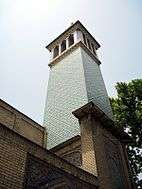
Golestan Palace, Tehran, Iran
-
Example in Souq Waqif, Doha, Qatar
See also
Notes
- ↑ The earth stays cool by virtue of being several meters below the surface
References
- ↑ Malone, Alanna. "The Windcatcher House". Architectural Record: Building for Social Change. McGraw-Hill.
- ↑ Folklore and Folklife in the United Arab Emirates. p. 167.
- 1 2 A. A'zami (May 2005). "Badgir in traditional Iranian architecture" (PDF). International Conference "Passive and Low Energy Cooling 1021 for the Built Environment", May 2005, Santorini, Greece. Retrieved 21 March 2012.
- ↑ Air-conditioning avoidance Archived October 23, 2007, at the Wayback Machine.
- ↑ Ahmed Abdel Wahab Ahmed Rizk; Mohamed Abdel Mawgoud Abdel Ghaffar; Mohamed Hefnawy (11 April 2007). "The effect of wind-catchers (el-Malaqef) on the internal natural ventilation in hot climates with special reference to Egypt: A study on small physical models" (Microsoft Word document (.doc)). www.aun.edu.eg (in English and Arabic). Asyut: Assiut University. p. 1. Retrieved 21 September 2016.
EL-MALAQEF
- ↑ "Using Computational Fluid Dynamics to Study Flow Patterns of Egypt Windcatcher Named MALQAFS" (PDF). Retrieved 2013-04-22.
- ↑ "Industrial architecture in Egypt in the 19th and 20th centuries, Arsenal in the Citadel of Cairo: workshop hall with timber roof construction and wind catcher (malqaf)". Dainst.org. Retrieved 2013-04-22.
- ↑ "Designing the Malqaf for Summer Cooling in Low" (PDF). Retrieved 2013-04-22.
- ↑ Ghobadian, Vahid (2007). "بادگير (badgar)" (in Persian).
- ↑ Fathy, Hassan. "The wind factor in air movement". Natural Energy and Vernacular Architecture.
- ↑ nps.gov http://www.nps.gov/zion/learn/nature/zion-canyon-visitor-center.htm. Missing or empty
|title=(help) - 1 2 "How Ancient Persian Architecture Captured Wind Energy Underground to Green Buildings". This Big City.net. Retrieved 21 March 2012.
External links
| Wikimedia Commons has media related to Windcatcher. |
- G.R Dehghan Kamaragi (January 2016): http://www.badgir-persian-gulf-en.com
- Bahadori, Mehdi N. (February 1978). "Passive Cooling Systems in Iranian Architecture". Scientific American. 238 (2): 144–154. doi:10.1038/scientificamerican0278-144. Retrieved 2007-07-17.
- Bahadori, Mehdi N. (August 1994). "Viability of wind towers in achieving summer comfort in the hot arid regions of the middle east". Renewable Energy. 5 (5–8): 879–892. doi:10.1016/0960-1481(94)90108-2.
- Richter, Jim (2003). "Liberty Ship Photo".
- Montazeri, H.; Azizian, R. (December 2008). "Experimental study on natural ventilation performance of one-sided wind catcher". Building and Environment. 43 (12): 2193–2202. doi:10.1016/j.buildenv.2008.01.005.
